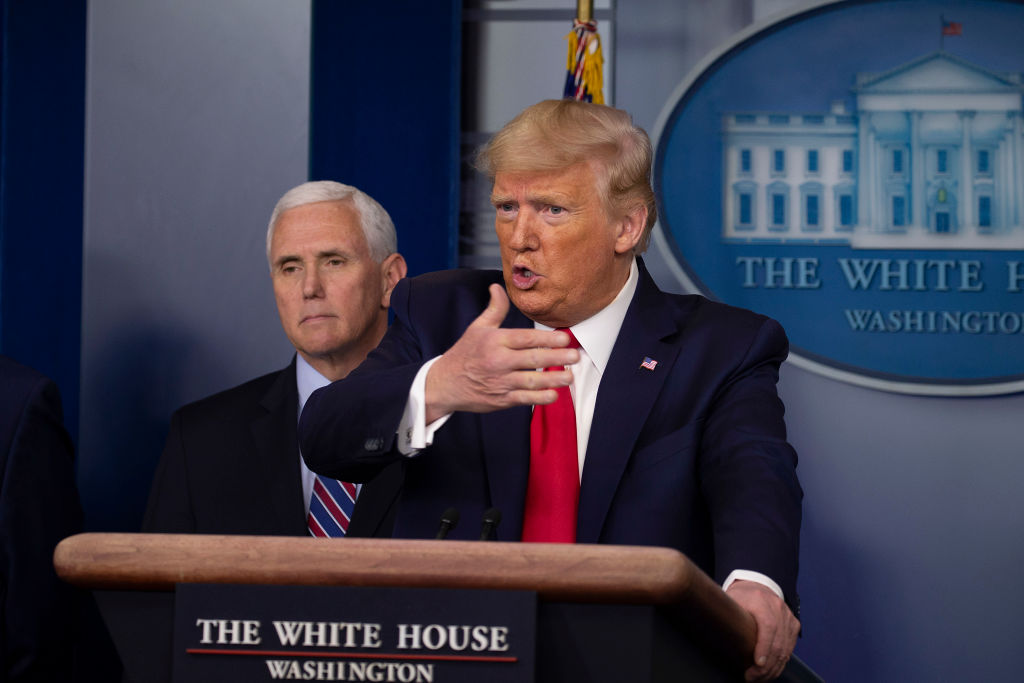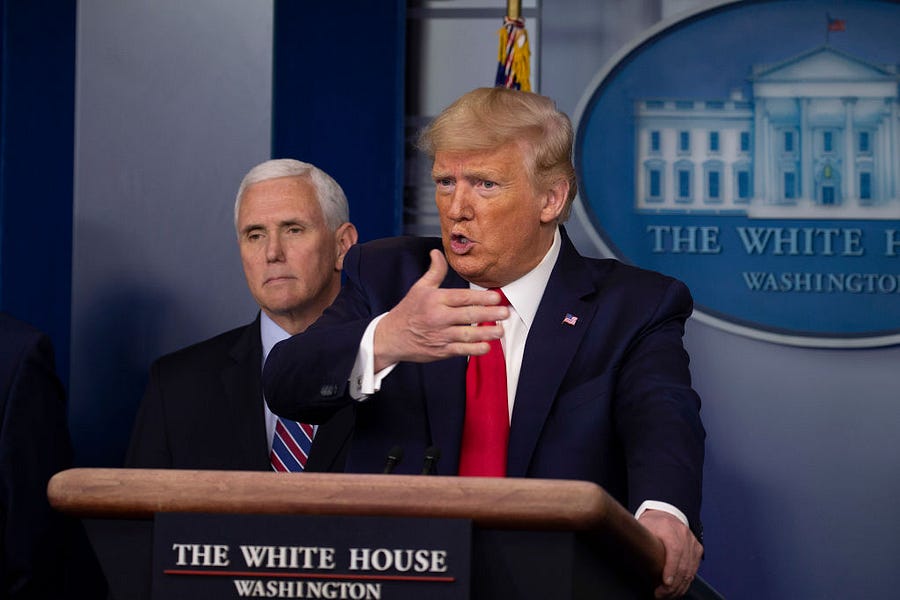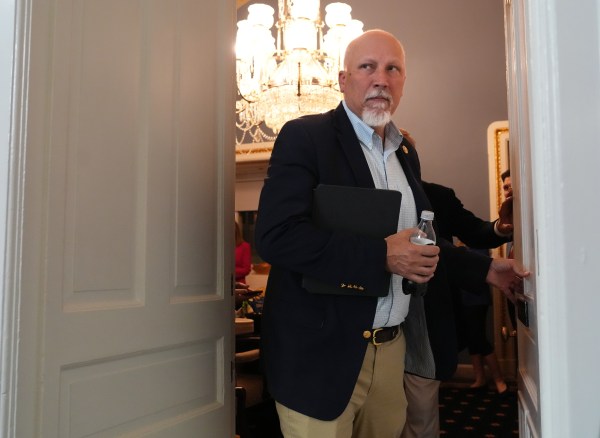Happy Tuesday. It is Tuesday, isn’t it? The days are starting to run together now that we never see the sun.
Quick Hits: Today’s Top Stories
-
As of Monday night, there are now 46,438 confirmed cases of COVID-19 in the United States (a 40 percent increase from yesterday) and 586 deaths (a 41 percent increase from yesterday), leading to a mortality rate of 1.3 percent, according to the Johns Hopkins University COVID-19 Dashboard. About 15 percent of all coronavirus tests in the United States have come back positive, per the COVID Tracking Project, a separate dataset with slightly different top-line numbers.
-
The Senate failed yet again on Monday to reach agreement on the $2 trillion stimulus package negotiators are hammering out—46 of 47 Democrats voted against advancing the proposed legislation—but both Treasury Secretary Steven Mnuchin and Minority Leader Chuck Schumer expressed optimism a deal would be reached today.
-
The 2020 Olympics in Tokyo are increasingly likely to be postponed until next year. The International Olympic Committee (IOC) has not made any formal announcements, but IOC member Dick Pound told USA Today “the games are not going to start on July 24, that much I know.”
-
After initially pursuing a more lax approach to “mitigate” rather than “suppress” the virus, the United Kingdom is changing course. Prime Minister Boris Johnson announced a three-week nationwide lockdown, ordering residents to stay at home.
-
The Federal Reserve announced additional measures to mitigate the economic harm wrought by the coronavirus pandemic.
-
Although Twitter launched a PR campaign to tout its new measures against disinformation and state-backed fake news earlier this month, the social media site has decided that false information tweeted by senior Chinese officials about the coronavirus’ origin, does not violate its terms of service.
-
A study published by the CDC on Monday found that the coronavirus survived on cruise ship surfaces for up to 17 days after passengers disembarked, far longer than previous research indicated it could.
‘Our Country Wasn’t Built To Be Shut Down’

The second full week of the American shutdown began with Dr. Jerome Adams—U.S. surgeon general—appearing Today to warn that the week ahead “is going to get bad.” And if Monday was any indication, he is right.
More than 45,000 Americans have now tested positive for the coronavirus, and that number will only climb. The New York Times reports that nearly half the country’s population is now subject to some kind of stay-at-home order. The Army Corps of Engineers is transforming the Javits Convention Center in New York into a 1,000-bed field hospital. Congress failed to reach agreement on a stimulus package that is becoming increasingly urgent as millions of Americans suddenly find themselves out of work or their hours reduced.
There are some positives, yes. Businesses large and small have retooled their operations to manufacture or source products—from hand sanitizer and masks to test kits and ventilator parts—needed to fight coronavirus. The administration issued an executive order aimed at cracking down on the hoarding of such supplies. The number of new coronavirus cases in Italy fell for the second straight day.
But the United States is nowhere near out of the woods yet. As New York Gov. Andrew Cuomo said, “This is going to get much worse before it gets better. … We are still in the relative calm before the storm.”
Yet cracks in our unified front to confront the virus have begun to show.
“Our country wasn’t built to be shut down,” President Trump said during a Monday evening briefing at the White House, signaling he was eager to reopen the U.S. economy and perhaps relax some of the drastic measures recommended by public health professionals to slow the spread of COVID-19. “America will, again, and soon, be open for business. Very soon. A lot sooner than three or four months that somebody was suggesting. Lot sooner. We cannot let the cure be worse than the problem itself.”
Trump was picking up on increasing calls from some conservatives—in both mainstream outlets like the Wall Street Journal and those on the nationalist-populist right—to reconsider his decision to prioritize eradicating the virus even as doing so causes economic damage. The president has long planned to build his reelection campaign around the thriving economy that still looked strong just a few short weeks ago. He has not yet made any declarations one way or the other about easing existing CDC guidance but suggested that a decision to change course could come in a week. “At the end of the 15-day period, we’ll make a decision as to which way we want to go,” he said on Monday night, several times using the past tense to describe mitigation efforts. It’s clear the president is not in the same place he was just a few short days ago when he said, “The market will take care of itself. … The market will be very strong as soon as we get rid of the virus.”
Many public health professionals unsurprisingly reacted with alarm at the prospect of relaxing ongoing social distancing efforts, which they say will go a long way toward flattening the curve if we keep at them. Dr. Scott Gottlieb—Trump’s former Food and Drug Administration commissioner—pushed back on this emerging sentiment after the president’s press conference.
Dr. Tom Inglesby, director of Johns Hopkins University’s Center for Health Security, offered a long warning on Twitter, excerpted below.
These big social distancing measures take time to work. The impact of big interventions in Wuhan China took about 3 wks to start to reverse things. And then everyday after the situation got better. In the U.S., we’re about 7 to 10 days into this, depending on the state. To drop all these measures now would be to accept that COVID [patients] will get sick in extraordinary numbers all over the country, far beyond what the U.S. health care system could bear. Many models report that health care systems will be completely overwhelmed/collapse by the peak of cases if major social distancing is not put in place. If a health care system in a given community stops working, can no longer provide care to the ill, the case fatality rate for COVID will be far higher than 1 percent—we would not be able to care for some or all of the expected 5 percent of recognized cases that get critically ill. Beyond that, if hospitals were completely overwhelmed, they may struggle to provide even oxygen for some or many of the 15 percent of recognized cases expected to be “severely ill.” Let alone provide care for other life-threatening conditions. Anyone advising the end of social distancing now, needs to fully understand what the country will look like if we do that. COVID would spread widely, rapidly, terribly, could kill potentially millions in the year ahead with huge social and economic impact across the country. Before considering big changes to social distancing measures now, we should as quickly as possible get to strongest possible position for COVID response—we’re nowhere near that now.
Gottlieb and Inglesby both touch on a point worth reiterating: The economy is in shambles, yes, because states and localities have been locking down commerce—but also because we are in the midst of a deadly pandemic. Set aside for a minute the fact that governors—not the federal government—hold the relevant legal authority over quarantines and shutdowns. Even if Trump were to “open the United States for business” once again in a few day most Americans would continue to stay at home and avoid restaurants, travel, and unnecessary public exposure. And yet the health care system would continue to be overwhelmed. Many of our trading partners would remain in a state of mass closure.
‘There Is No Perfect Answer To All This’
With all that said, of course it’s still important that American policymakers remain vigilant about which and how much economic pain can be avoided, if possible. Up on the site today, Andrew has a piece breaking down the thorny ways in which the two concerns play into one another:
“I think we are in the process of facing two public health emergencies,” he said. “The first is that caused by the suffering, hospitalization, and death caused by this virus. The second is the public health emergency that’s going to come when we have a major financial downturn. … You have joblessness, which leads to homelessness, which leads to despair, which leads to mental health-associated physical problems, which leads to depression, which leads to child abuse, which leads to domestic abuse, which leads to violence and crime. So it’s all a public health issue. It’s sort of pay me now, pay me later. There is no perfect answer to all this.”
…
Simply allowing the economy to stall out for months is likely to vaporize millions of jobs, forcing innumerable Americans out of their livelihoods, off their health insurance, even out of their homes. To stand by and allow such a collapse risks not only economic ruin, but a nearly guaranteed second public health crisis—exactly the thing we’d be supposedly tanking the economy to prevent.
Yet the opposite case promises no better. Epidemiologists speakwith one voice on this: If distancing efforts are abandoned too early, the coronavirus will simply resume its brisk and vicious colonization of the entire United States. Hospitals will totter under the impossible strain of trying to treat critically ill patients by the dozens, hundreds, thousands. Millions may die, both from the virus and from the simple lack of the medical resources and attention that is ordinarily abundant. And after all this—because of all this—the economy would tank again anyway.
If neither extreme is acceptable, then the nation’s task becomes working out what the proper balance, that brings the least harm to the most people, is likely to be. But this task too is incredibly difficult. It’s not a simple question of how many businesses we can ask to remain closed. Stabilizing the economy requires providing clarity to business owners about exactly how long they can expect the shutdown to last, so they can plan around the financial hit best they can in the meantime. But fighting the epidemic effectively requires exactly the opposite approach: Waiting for the data to come in on how effective containment has been before making any decisions about whether and where to relax active measures.
Worth Your Time
-
Yuval Levin has a great piece over at The Atlantic touching on some similar themes. “Right now, we need to pause. In order to restrain the spread of the virus, we have put our lives on hold—with work, school, and play all shut down to let us keep our distance from one another,” he writes. “At the same time, however, the pause we are in cannot last, even for the medium term. The notion that this is how we handle the virus until a vaccine is available—that the most intense social distancing with no school or work for large segments of society will go on for many months—is absurd. No policy maker should take it seriously. Rather, the purpose of the hard pause is to enable the gradual resumption of life to start soon.” Be sure to give it a read, and let us know what you think of his prescriptions on how to best gradually return to normalcy in the comments.
-
This Twitter thread—from Dr. Craig Spencer of New York-Presbyterian/Columbia University Medical Center—provides a glimpse into the harrowing life of an emergency room doctor on the front lines of the fight against the coronavirus. His conclusion: “You might hear people saying it isn’t real. It is. You might hear people saying it isn’t bad. It is. You might hear people saying it can’t take you down. It can. I survived Ebola. I fear #COVIDー19. Do your part. Stay home. Stay safe. And every day I’ll come to work for you.”
-
Sen. Amy Klobuchar announced via Medium that her husband, John Bessler, has been hospitalized with a serious case of COVID-19. Her short post on the subject is worth reading in full. “I love my husband so very much and not being able to be there at the hospital by his side is one of the hardest things about this disease,” she writes. “I hope he will be home soon. I know so many Americans are going through this and so much worse right now. So I hope and pray for you, just as I hope you will do for my husband.”
-
Jim Geraghty has a great rundown of China’s catastrophic coronavirus obfuscation and the havoc it has wreaked across the globe, dating back to December, in his Morning Jolt newsletter. “You have probably not heard … how emphatically, loudly, and repeatedly the Chinese government insisted human transmission was impossible, long after doctors in Wuhan had concluded human transmission was ongoing,” he writes. “We can only wonder whether accurate and timely information from China would have altered the way the U.S. government, the American people, and the world prepared for the oncoming danger of infection.”
Presented Without Comment
Also Presented Without Comment
Also Also Presented Without Comment
Toeing the Company Line
-
The latest Advisory Opinions podcast isn’t all COVID-19—just mostly COVID-19! Join Sarah and David as they discuss the jurisdictional clash between the federal government and the states that could be coming down the pike if President Trump decides to ease up on social distancing guidance while governors forge ahead with lockdowns and quarantines. Be sure to stick around for a conversation about the U.S. women’s soccer team and its equal pay lawsuit.
-
If you missed it Monday, Fredrick Hess and Nat Malkus looked at Kansas’s decision to close schools for the rest of the year and suggested that states have a little more time before they must make such a final decision.
Let Us Know
In Monday’s Morning Dispatch we asked you to share with us your most paranoid new habits in the coronavirus era. You did not disappoint. Some of our favorites:
-
Rob: Watching an old movie and my initial reaction was to judge characters for shaking hands instead of following the rules.
-
Kimberly: I’m journaling everywhere I’ve been and everyone I’ve been in contact with.
-
Aaron: I bought a really horrible looking frozen “pizza” just because it was the last one on the shelf.
-
Ray: I’ve seriously considered stopping delivery of my local newspaper. I just keep picturing the driver sneezing all over them.
-
Patricia: I bought some new furniture and after they delivered it, I wiped everything down the delivery guys touched. Then since I donated my old furniture, I hired a guy I’ve used before to pick the items up. My dog loves him, and he was holding her and kissing her and as soon as he left I put her in the sink and gave her a bath. I also wiped down everything for the second time. I’ve never thought about germs so much in my life and I’m 59. Now I see germs everywhere!
Reporting by Declan Garvey (@declanpgarvey), Andrew Egger (@EggerDC), Alec Dent (@Alec_Dent), Sarah Isgur (@whignewtons), and Steve Hayes (@stephenfhayes).
Photograph by Tasos Katopodis/Getty Images.







Please note that we at The Dispatch hold ourselves, our work, and our commenters to a higher standard than other places on the internet. We welcome comments that foster genuine debate or discussion—including comments critical of us or our work—but responses that include ad hominem attacks on fellow Dispatch members or are intended to stoke fear and anger may be moderated.
With your membership, you only have the ability to comment on The Morning Dispatch articles. Consider upgrading to join the conversation everywhere.